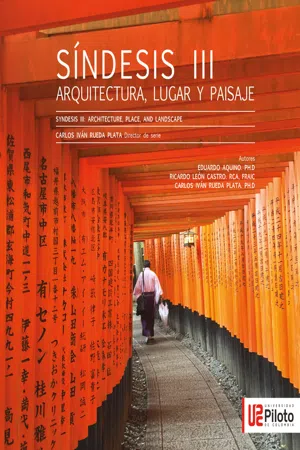
Sindesis III
Arquitectura, lugar y paisaje
- Spanish
- ePUB (apto para móviles)
- Disponible en iOS y Android
Información del libro
"El proyecto investigativo general de Síndesis busca abrir horizontes en los procesos metodológicos para la creación de obras arquitectónicas y proyectos de lugar y, de forma correlacionada, también para ofrecer estrategias de interpretación o re-creación por conducto de la crítica. De esta forma, la crítica retroalimenta la obra y la obra, a su vez, estimula la crítica en un proceso re-creativo que, más que circular, yo lo ilustraría como una espiral." "En esta edición de Síndesis III, se ha vinculado al proyecto el profesor Eduardo Aquino, con un capítulo en el que desarrolla una propuesta original sobre una condición de entornoplaya, no necesariamente re- lacionada con la playa como tal, en un sentido geográfico literal, sino concebida como espacio público cualitativo y lugar para el ocio crea- tivo, tan necesario para una sociedad contemporánea." "Ricardo L. Castro retorna a esta serie con un ensayo en el cual, du- rante un peregrinaje personal anual, lanza una mirada sindética desde Delfos. Allí encuentra un sinnúmero de relaciones con sus experiencias de la Capilla Campestre del Hermano Klaus diseñada por Peter Zumthor en el sur de Colonia, Alemania. La experiencia física, la "inmediatez del lugar", término acuñado por el propio Castro, combinada con la inmediatez conceptual y cultural con el "locus", sirven para entender y poder intervenir en el lugar (ya sea por medio del diseño, la escritura, la música) en una forma apropiada y contribuyen a un desarrollo del manuscrito en forma típicamente sindética." "Mi texto para Síndesis III, retoma el ejemplo ya explorado por Castro, la Capilla Bruder Klaus, para desarrollar una tesis al respecto de la relevancia que tiene la intencionalidad en el proceso creativo, e inter- pretación de la arquitectura, con orientación fenomenológica. El texto en sí es sindético, pues pone juntas — o hace una síndesis de— teorías que provienen de la literatura, la filosofía, y la arquitectura. La tesis puntual de este capítulo se centra en mostrar qué, con "instrucciones del autor" en la Capilla Bruder Klaus, Zumthor celebra los rituales poéticos de la construcción misma de la obra. La capilla se convierte" "entonces en un memorial poético de su propia construcción."
Preguntas frecuentes
Información
A GAZE FROM DELPHI:BRUDER KLAUS FIELD CHAPEL |
Índice
- Portada
- Portadilla
- Créditos
- Autores
- AGRADECIMIENTOS
- Acknowledgements
- Tabla de Contenido
- ESTUDIO INTRODUCTORIO
- DIBUJAR LA PLAYA:
- EXPERIENCIA AUMENTADA
- UNA MIRADA DESDE DELFOS:
- INTRODUCTORY STUDY
- DRAWING THE BEACH: BOUNDARY DEFORMING IN THE CONFLUENCE OF ART, ARCHITECTURE, AND LANDSCAPE
- ENHANCED EXPERIENCE BY “AUTHORIAL INSTRUCTION”: THE BRUDER KLAUS CHAPEL BY PETER ZUMTHOR
- A GAZE FROM DELPHI: BRUDER KLAUS FIELD CHAPEL
- REFERENCIAS